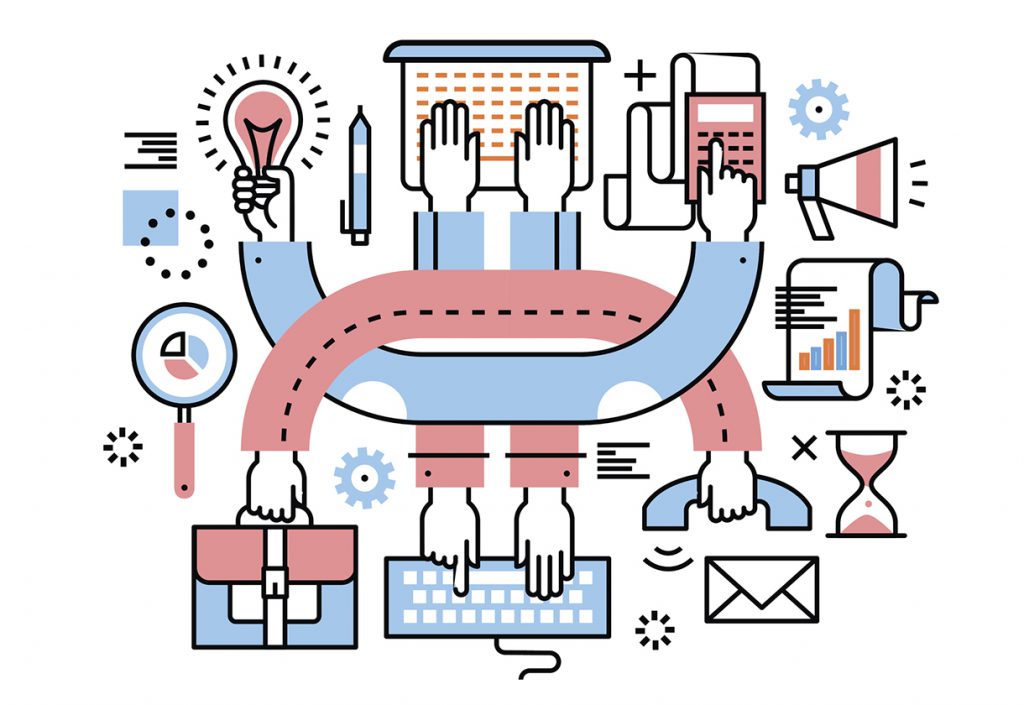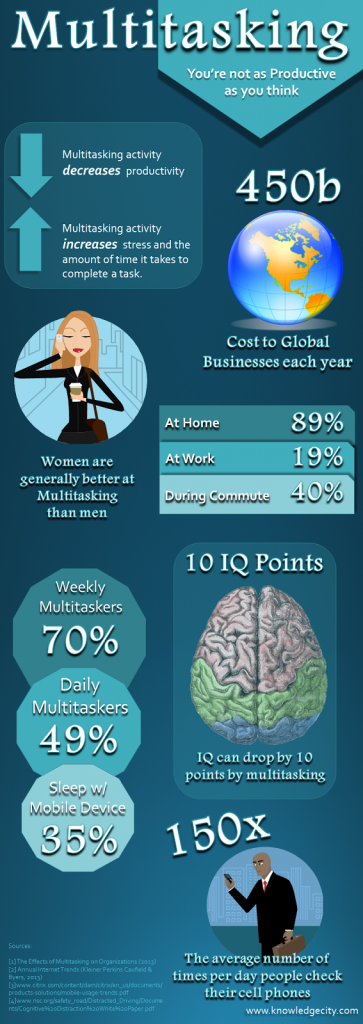Multitasking refers to the ability of a person or a computer to perform multiple tasks or processes simultaneously. In the context of human behaviour, multitasking typically refers to the practice of doing several things at once, such as working on a computer while talking on the phone or watching television. In the context of computing, multitasking refers to the capability of an operating system to run multiple programs or processes at the same time and switch between them, providing the illusion that they are all running simultaneously.
While multitasking can increase efficiency and productivity in some situations, it can also lead to decreased productivity and cognitive overload when trying to perform too many tasks simultaneously, as it can be difficult to give each task the attention it deserves.
Today, multitasking is common because of the fast-paced world we live in as people try to balance multiple tasks and responsibilities at once. While multitasking can have some benefits, it also has several drawbacks that need to be considered. Below are some of the pros and cons of multitasking which can help determine whether it is the right approach.
Multitasking can be good in certain situations where the tasks being performed are relatively simple, require little cognitive effort, and can be performed simultaneously without interfering with each other. Like listening to music while exercising or working on a simple task, as the music provides background stimulation that can help boost motivation and energy levels. Or even cooking and cleaning at the same time, as they are both physical tasks that can be performed simultaneously without much cognitive effort.
It’s important to note that multitasking should be approached with caution, as it can also be detrimental to performance and productivity when tasks are too complex or demand too much attention. In such situations, it’s better to focus on one task at a time and give it the full attention, to avoid mistakes and increase efficiency.
There are several benefits to multitasking, including:
Increased efficiency and productivity: When done effectively, multitasking can help increase overall productivity by allowing one to tackle multiple tasks at once. By performing multiple tasks simultaneously, one can save time and increase overall productivity. This can be especially useful for individuals who are juggling multiple projects or responsibilities.
Improved time management: Multitasking allows one to complete multiple tasks in a shorter period, prioritise tasks and manage time more effectively, enabling one to complete more tasks in a given amount of time. By switching between tasks, one can keep their brain active and focused, allowing them to get more done in less time.
Better decision-making: Multitasking can also help people to make better decisions by allowing them to consider multiple options and viewpoints at once. When one is constantly shifting their focus between tasks, they are forced to weigh the pros and cons of each option, leading to more informed and well-rounded decisions.
Better utilisation of downtime: Multitasking can help one to make better use of downtime that may occur during the day, such as waiting in line or commuting.
Reduced boredom: Multitasking can help keep one engaged and reduce boredom, especially when performing monotonous tasks.
Improved mental stimulation: Multitasking can provide mental stimulation and help keep one alert and focused, especially when switching between tasks that require different skills and abilities.
Multitasking has several drawbacks, including:
Decreased focus and attention: When multitasking, it can be difficult to give each task the attention it deserves, leading to decreased focus and attention, and an increased likelihood of making mistakes. Multitasking can also decrease the overall focus and attention, as one is constantly shifting their attention from one task to another. This can make it difficult to concentrate on any one task for an extended period, leading to decreased efficiency and effectiveness.
Decreased quality: While multitasking may help one to complete more tasks in a shorter period, it can also result in a decrease in the quality of their work. When one is constantly switching between tasks, it can be difficult to give each task the attention and focus it deserves, leading to mistakes and subpar results.
Increased stress and anxiety: Multitasking can also be stressful, as it requires one to constantly be on the go and make quick decisions. This can lead to burnout and decreased mental health, as the brain becomes overwhelmed by the constant demands of multitasking. Multitasking can lead to feelings of stress and anxiety, especially when tasks pile up and become overwhelming.
Decreased creativity: Multitasking can also stifle creativity, as it requires one to constantly be in a state of “doing” rather than allowing one to take the time to reflect and think. When one is constantly multitasking, one may be missing out on opportunities for creative problem-solving and innovation because it requires one to divide their attention and switch between tasks frequently.
Decreased overall productivity: Despite the perception that multitasking saves time, research has shown that it can decrease overall productivity, as switching between tasks takes time and energy, and can lead to decreased focus and attention.
Impairment of memory: Multitasking can lead to an impairment of short-term memory, as information may not be encoded or retained as effectively when divided attention is required.
It’s worth noting that while multitasking can have these benefits, it can also lead to decreased productivity and cognitive overload when tasks are too complex or demand too much attention. It’s important to approach multitasking with caution and to be mindful of your limitations to maximize its benefits. A rule of thumb should be that multitasking should be approached with caution, and it’s important to be mindful of limitations and to prioritise tasks to ensure that one is focusing on the most important and time-sensitive tasks first.
In conclusion, multitasking can be a useful tool for managing time and increasing productivity, but it also has its drawbacks. By weighing the pros and cons of multitasking, one can determine whether it is the right approach to take. If one finds that multitasking is causing stress or decreasing the quality of work, it may be time to reassess the approach and find a more balanced and sustainable way of working.





